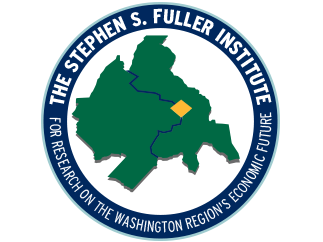From The Washington Business Journal:
Greater Washington’s economy grew better than expected last year and is on track for a stronger 2018 — although it’s still underperforming the national economy.
The gross regional product grew about 2.1 percent in 2017, far more than the 1.1 percent growth the region saw in 2016. And the economy is projected to grow about 2.3 percent in 2018, according to a new report by economist Stephen Fuller, head of George Mason University’s Stephen S. Fuller Institute.
The data are slated to be released Thursday at the 26th annual Economic Conference. The event — originally held by Cardinal Bank, now United Bank (which purchased the Tysons-based bank) — is held in conjunction with the Northern Virginia Chamber of Commerce, George Mason University and the Washington Business Journal.
The report paints a picture of an improving economy in the D.C. region, although the GRP number is still expected to lag behind the projected 2.7 percent growth in national gross domestic product this year. Part of that national boost is expected to come from the recently passed tax reform law, which is expected to add 0.3 percent to GDP. Fuller did not include the expected effect of the tax law on the his growth number for the regional economy, but he expects to give it a small bump.
Looking to 2019, Fuller expects the gross regional product to grow at 2.1 percent, compared with a national number of 2.6 percent. He expects both the national and local economies to grow at about 2 percent in 2020.
“Getting up to national GDP levels is quite an achievement,” Fuller said, although he added the region won’t grow at the high rates it had seen in years past. “We are not going to be where we used to be, at least in the short term.”
The report also shows:
- Federal employment in the region grew by just 100 jobs from 2016 to 2017, with some federal jobs actually lost in the second half of last year. Fuller projects that federal jobs will decline in 2018.
- Professional and business services accounted for 16,600 new jobs in the region with leisure and hospitality jobs a close second with 13,500 jobs added from 2016 to 2017. Education and health services, which saw an increase of 12,600, rounds out the top three sectors, which accounted for nearly 76 percent of job creation from 2016 to 2016.
- Most of the future job growth will accrue in Northern Virginia. While suburban Maryland added 23,200 jobs compared to Northern Virginia’s 21,600 and D.C.’s 9,600 in 2017, Northern Virginia will add 25,900 jobs in 2018 compared to 11,000 in Maryland and 4,600 in 2019 — a trend that will only get worse over time.
And as the region adds jobs, those jobs generally pay less than the more lucrative federal jobs the region has grown accustomed too for so long. That means the region needs to add more lower quality jobs to retain the same growth, Fuller said. Meanwhile federal losses will mount, with 5,300 federal jobs projected to be lost in 2018 and another 3,600 in 2019.
“Part of the story is that we still have this anchor or albatross — this burden of the great importance of federal spending within the economy,” Fuller said. “It undermines some of our forward motion.”
Copyright Washington Business Journal, reprinted with permission
